Note: The basic tenants of a “UX adventure” are covered in more detail in the UX Magazine article: UX Adventure: Enhance your resume, improve your career potential, and feel the excitement!

For me, the comment reflected one of the core tenants of the UX adventure framework that I initially proposed in a blog post in 2012 which the following year became the UX Magazine article: pushing my user experience colleagues not to just follow the path of least resistance, but to change things up a bit, and to initiate their own career adventures beyond their regular employment to ultimately enhance their career potential.
That evening, once the conference had ended, I went to a local pub with a number of conference attendees and had the opportunity to have a long discussion with the tweeter, Amanda Stockwell. After some probing about how that comment had resonated with her, it was easy to see that Amanda was quite interested in what I would consider to be part of the work adventure framework as well.
Two days later, I had the opportunity to catch up with Dan Szuc while we were both still in town from the conference. I described the resonance of that tweet and how the content of the tweet itself was a marker for a UX adventurer. In the course of our conversation, Dan asked me a very good question: Could someone really become an adventurer? Could someone be trained to embrace this framework, this philosophy? While I’d spoken about UX adventure and talked about the principles of these adventures a number of times, I hadn’t really given much thought to how someone could really learn to be a work-adventurer.
Basic tenants of a work adventure
I originally proposed the term “UX Adventure” to refer to the creation of UX-related activities unrelated to one’s current employment. These adventures are described as potentially unpaid and often occurring outside of work hours. The goal of the adventures is not only to do something exciting but also to enhance one’s career. In the UX Magazine article published in March 2013, I noted that nobody else was using the term “UX Adventure.” While I would not be so bold as to take full credit for the proliferation of the term, it is heartening to see so many new references on UX adventures (with admittedly varying definitions) since that point. That said, in the discussion below, I’d now like to think about work adventure training beyond just UX.
Concrete value of a work adventure
A non-work adventure may be simply for the thrill of the adventure. A work adventure, whether or not it’s actually paid, is not just about making existing employment more thrilling. A work adventure is about ways to enhance current and future employment, project marketability and overall career potential. But it’s okay, and desirable, to feel the thrill along the way. A work adventure is about exposure to those in your chosen profession. A work adventure is about being known, about being visible and being noticed professionally, beyond just by your employer.
Prerequisites
While there are not too many prerequisites to being a work-adventurer, there are a few. If those prerequisites are not met, it will be very difficult to create a work adventure.
You have to want adventure: First and foremost, you have to want to have an adventure – and not just scaling a high mountain, or taking an adventurous trip either – you have to accept that something that you are willing to call work is, in fact, able to excite you.
You should be about to feel the adventure: There is a thrill to adventure – that is why I use the term “adventure.” And just like a non-work adventure, a work adventure should be thrilling to you. For me, it’s a feeling, a rush of tangible excitement. Just by having an engaging conversation with likeminded individuals, I feel it too – and the overlapping adventure-energy is quite powerful!
While these may be prerequisites for having that work adventure, that doesn’t mean that one needs to be fully aware that the desire for adventure exists within them. Rather they perhaps need to at least realize that sitting at a desk at work and doing their day job is not all that there is to their present and future employment – that there is something bigger. And when asked to choose between the red pill and the blue pill, they choose the red pill.
Believing is Seeing: My mantra since my teen years has been “Believing is seeing.” I remember printing this out across three attached dot-matrix pages in those years and pasting the message above the door to my bedroom so that I would never forget. Believing is seeing. This short and simple phrase, an inversion of the typical “Seeing is believing” means that an adventurer must be able to envision what they want in order to make it happen. While there is certainly a very rational value explanation of the value of this mantra, I’d even take this one step further – for me, there seems to be a metaphysical aspect to this that is beyond rationality: sometimes good things that you want to happen do happen without an apparent causal relationship beyond the desire for said happenings.
While I would never want to say that an acceptance of “Believing is seeing” is required at a metaphysical level, I would think that at a minimum, one has to be able to see the adventurer that they want to be. Without being able to envision who they want to be, any attempt to become an adventurer will at best be fragmented and half-hearted.
Identifying your adventure
Who are you? The first and most critical portion of this work adventure curriculum would be a visioning of who you are now and who you want to be. The involves a certain amount of self-reflection and perhaps a verbal or written acknowledgement of who you are as an individual and what hats you may wear in life. Yet this adventure, while tangentially related to general self-reflection and goal-directed self-actualization, at its core is about how you can find the most meaning through work – but going back to the aforementioned tweet, work that perhaps doesn’t mean obediently following a standard definition of what it means to work.
The training should facilitate an exploration of attendees understanding of who they are as individuals and how that fits into their existing professional self-image. The training should examine how individuals can ever so slightly bend some norms and critically evaluate expectations of what it means to be a worker.
What are you passionate about? In addition to who you are, to have an adventure you need to be doing things that you love. Those things do not have to be rooted in your work per se, but you would need to have the opportunity to creatively come up with things that can tie together who you are with what you love and simultaneously provide work value. In the UX Magazine article, I talked about organizing a hike at one point to provide networking opportunities with other user experience professionals in my area.
An adventure-oriented curriculum should help people to identify their passions, perhaps from among a list of potential adventures, but still providing an opportunity for open-ended possibilities.
Framing your online image
Self-awareness and identification of adventures is only the first step. Much more concretely, you need to make sure that others see you in a way that will allow you easy access to your adventures. Simply put, others are going to Google you and review your background via a search. If you have a unique name (like “Cory Lebson”) finding out all about you will be very easy. In addition, they will review your social media profiles to learn about you.
A work-adventure curriculum would need training on how to create a profile that tells people the story of who you are. This story must be both honest and cohesive. This curriculum should also include training on how to properly leverage social media to put out your siren call – both directly and indirectly framing your image and letting others know that you are having work adventures and that you want more.
Are you really an introvert?
I have seen plenty of people in the UX community and otherwise brand themselves as an introvert. Yet, I don’t believe that there are as many people out there who are introverts as one would be led to believe. In fact, shyness is often confused with introversion. Many UX-ers, and I’d suggest many people, are, in fact, neither a true introvert, nor a true extrovert. I’m happily an ambivert. There are some times, in social situations, I get such a thrill and so much energy from that social situation. Yet there are other times when I know my energy is coming from within – when I just need to be alone. And you may be the same way.
A curriculum of work adventure should help differentiate between introversion and shyness. Overcoming that shyness can help ease the pathway to many more adventures.
How do you network?
To piggyback off of the question of introversion vs. shyness, part of a work adventure means having exposure to many people. While this is certainly easier if one is extroverted, and there are certainly ways to network virtually too (for example with the use of social media), it is also important to put yourself in situations where you have opportunities for in-person interaction. Along with the simple exposure to those situations, it’s important to learn how to frame who you are and what you want out of your career and your work adventures. That leads to the importance of an elevator pitch workshop.
An elevator pitch workshop, working through how you can capture your professional essence verbally in less than a minute, is also important to incorporate. I often do elevator pitch workshops as part of speed networking activities. While the elevator pitch workshop is more formal training than the speed networking itself, the truth is that the speed networking activities are also just as much of a training – pushing people to network in a controlled and structured environment.
Are you afraid of public speaking?
While a work adventure does not require public speaking skills per se, gaining exposure from doing talks certainly opens up doors to other things as well (and in my framework, those talks themselves can be adventures).
While for some people public speaking may be more natural than for others, assessing what topics one can speak about within his or her chosen profession and learning how to create effective slides with optimal use of graphics and a targeted message could be quite valuable. And simply having the opportunity to practice and talk about anything, work or otherwise, in front of a collection of people who are interested in listening could be a great confidence booster.
Pulling it all together
Once adventurers are ready for their first adventure, a training should give them the opportunity to get started – to research what specifically may be possible in their existing geography (or outside of their existing geography) and to perhaps initiate their first set of adventures. If their existing job is a barrier to work adventures, then there should be discussion on if or how to overcome these barriers. Perhaps a work-adventure curriculum also has the option for follow-on discussions – How are the adventures going? Where have their adventures taken them? What did they learn along the way, and what do they think that they still need to learn?
What else would you need to know?
What else am I missing? For those that are inclined to want work adventure, please let me know what else you’d like to know.
Image: Dynamicfoto / Bigstock.com with superimposed screenshot of Cory’s UX Magazine Article








